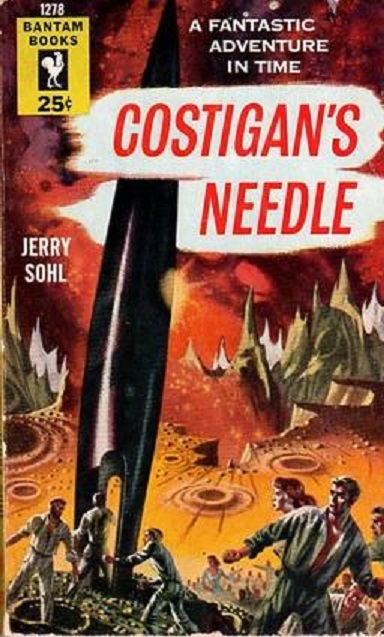Book Review: Costigan’s Needle by Jerry Sohl
The time: the very near future of 1953. The place, Chicago, Illinois. Engineer Devan Traylor would rather be at his Florida winter home with his wife and children for their first long break in years, but he’s just learned that Inland Electronics, the company he’s on the board of directors of, has authorized the payment of one million dollars for an experiment. In the 1950s, that’s a lot of money, and he wants to know what’s going on.

Devan is even less thrilled when he learns Sam Otto, a man who is notorious for backing dubious “inventions” is the one who brought this item to the attention of the directors. But after some pressure is applied, Devan gets to meet Dr. Costigan and see that this isn’t a normal fraud.
What Dr. Costigan has devised looks like a large upside-down sewing needle. There is a transparent field in the base hole; any living matter stuck into one side of the hole goes…elsewhere. Non-living organic matter attached to a living body like hair or fingernails also passes through, but not dead things by themselves. Nor does any non-organic matter like tooth fillings. Since you can see through the other side of the hole a cross-section of the living matter going through the field, there are obvious medical applications, just for a starter. But commercial use isn’t going to be possible until it’s determined just what “elsewhere” actually means. So a Needle large enough for a man to pass through must be built!
Some months later, after Devan has gotten to spend time in Florida, a Needle has been built with a hole eight feet high and four feet wide, ready to test with a human observer. A volunteer, Glenn Basher, sticks his head through. It’s dark and misty, he can’t see a darn thing. As they’re discussing a safe way to get him further in, Glenn slips and falls through the eye of the Needle. They wait, and he doesn’t come back. A short-circuit turns off the field and by the time they’ve got it working again, the cops arrive. One of the detectives falls through, and doesn’t come back. Things turn into a public circus, culminating in a human chain idea that results in the disappearance of three police officers.
The local religious fanatics have decided that the Needle is an abomination unto the Lord, and during an attempt to create a bridge through the eye with a potted tree, one of them sabotages the Needle. Instead of just shutting down, a power surge expands the field to several city blocks. Everyone disappears.
It turns out that the reason no one ever came back was that the other side of the needle is about twenty feet in the air above a lake. A few people die from the fall, and others drown, but the rest manage to make it to shore.
When the sun rises, several hundred naked Chicagoans find themselves in an unknown land, bereft of modern technology or even the most basic tools. However, they do have an engineer, a scientist, a retired dentist, a couple of interns, some Boy Scouts, and several people with useful hobbies. Survival is definitely an option.
According to the stars, they’re in Illinois the same year they left, but there are small differences in plants and animals that say it’s not the same Earth. A plan is made to create technology again, bypassing all the false starts of history, and creating a second Needle that will allow the stranded people to go home. Oops, the religious fanatics who also came through aren’t down with that.
Despite some hiccups, the small community thrives, and ten years later, it’s time to test the second Needle. What will be the result?
This science fiction novel neatly divides into two sections, first “we have a new technology but we need to figure out what it does”, and second “how do we survive starting from scratch?”
The latter is simplified by having the alternate Earth apparently not have any intelligent inhabitants, or at least not within walking distance. The conflict with the religious group is more or less settled by the onset of winter, which overcomes their objections to technology like clothing and artificial shelter. This is definitely a book for people who prefer to have humans be basically decent people who pull together in a crisis. It’s strongly suggested that the community’s lifestyle is far healthier physically and mentally than 1950s Chicago.
The ending is, well, perhaps pushing the idea of the united community a little too far, but there’s one last surprise that might still change things.
The characters are adequate to the purpose, none of them really explored outside the need of the plot to be advanced.
Content note: attempted sexual assault, quickly quashed. Devan and his love interest are both married and have presumably living spouses back in Chicago, but they’ve had children together during the time skip. In light of 1950s sexual mores, this is just never discussed at any point. Two of the main priorities of the stranded Chicagoans are smoking tobacco and drinking alcohol.
Overall: An okay story for its time. Getting to the part where Things Happen is agonizingly slow by modern standards. If you’d like to see the ideas of the second half explored in more detail, and with much more exciting action, check out the Dr. Stone manga and anime. The author went on to write “The Corbomite Maneuver” for Star Trek. Mostly for collectors, I think.

